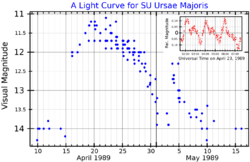Astronomy:SU Ursae Majoris
 A visual band light curve for the April 1989 superoutburst of SU Ursae Majoris, adapted from Udalski et al. (1990)[1] | |
| Observation data Equinox J2000.0]] (ICRS) | |
|---|---|
| Constellation | Ursa Major |
| Right ascension | 08h 12m 28.26946s[2] |
| Declination | +62° 36′ 22.4280″[2] |
| Apparent magnitude (V) | 10.8–14.96[3] |
| Characteristics | |
| Variable type | SU UMa[3] |
| Astrometry | |
| Radial velocity (Rv) | +27.0[4] km/s |
| Proper motion (μ) | RA: +6.582[2] mas/yr Dec.: −24.538[2] mas/yr |
| Parallax (π) | 4.5347 ± 0.0286[2] mas |
| Distance | 719 ± 5 ly (221 ± 1 pc) |
| Absolute magnitude (MV) | +5.1[5] |
| Orbit[6] | |
| Period (P) | 0.076351±0.000043 d |
| Inclination (i) | 42[5]° |
| Periastron epoch (T) | 2,446,143.6672±0.0015 HJD |
| Semi-amplitude (K1) (primary) | 59±7 km s–1 km/s |
| Details | |
| White dwarf | |
| Mass | 0.8[7] M☉ |
| Temperature | 28,000[7] K |
| Red dwarf | |
| Mass | 0.105[8] M☉ |
| Radius | 0.167[8] R☉ |
| Other designations | |
| Database references | |
| SIMBAD | data |
SU Ursae Majoris, or SU UMa, is a close binary star in the northern circumpolar constellation of Ursa Major. It is a periodic cataclysmic variable that varies in magnitude from a peak of 10.8 down to a base of 14.96.[3] The distance to this system, as determined from its annual parallax shift of 4.53 mas,[2] is 719 light-years. It is moving further from the Earth with a heliocentric radial velocity of +27 km/s.[4]
The variable nature of this star was discovered at the Moscow Observatory by Lidiya Tseraskaya (L. Ceraski) in 1908.[10] It was classified as a U Geminorum-type variable, or dwarf nova.[11] Observation since 1926 showed that this variable undergoes two different types of eruptions: a short maxima lasting around two days that ranged in brightness between 11.6–12.9 magnitude, and a longer maxima extending for 13 days that ranged between 10.4–11.8 magnitude. The later event came to be referred to as 'supermaxima'.[12] Similar dwarf novae of this class have since been discovered, and SU UMa is now the prototype for this sub-category of variable stars.[13]
This is a single-lined spectroscopic binary with an orbital period of 1.83 hours.[6] It consists of a white dwarf star that is acquiring matter from its close companion via an accretion disk. This disk is unstable and undergoes periodic outbursts which increase the luminosity of the system.[14] For SU UMa, the accretion rate from the companion is 9.8×10−13 M☉·yr−1.[15] X-ray emission has been detected in the vicinity of the white dwarf, which drops by a factor of four during outbursts. This emission is theorized to come from the boundary layer between the white dwarf and its accretion disk.[14]
See also
References
- ↑ Udalski, A. (July 1990). "SU Ursae Majoris: The Perfect Prototype of SU UMa Subclass of Dwarf Novae". The Astronomical Journal 100: 226. doi:10.1086/115508. Bibcode: 1990AJ....100..226U. https://ui.adsabs.harvard.edu/abs/1990AJ....100..226U. Retrieved 22 April 2022.
- ↑ 2.0 2.1 2.2 2.3 2.4 2.5 Brown, A. G. A. (August 2018). "Gaia Data Release 2: Summary of the contents and survey properties". Astronomy & Astrophysics 616: A1. doi:10.1051/0004-6361/201833051. Bibcode: 2018A&A...616A...1G. Gaia DR2 record for this source at VizieR.
- ↑ 3.0 3.1 3.2 Samus', N. N; Kazarovets, E. V; Durlevich, O. V; Kireeva, N. N; Pastukhova, E. N (2017). "General catalogue of variable stars: Version GCVS 5.1". Astronomy Reports 61 (1): 80. doi:10.1134/S1063772917010085. Bibcode: 2017ARep...61...80S.
- ↑ 4.0 4.1 Duflot, M. et al. (December 1995). "Vitesses radiales. Catalogue WEB: Wilson Evans Batten. Radial velocities: The Wilson-Evans-Batten catalogue". Astronomy and Astrophysics Supplement 114: 269. Bibcode: 1995A&AS..114..269D.
- ↑ 5.0 5.1 Patterson, Joseph (2011). "Distances and absolute magnitudes of dwarf novae: Murmurs of period bounce". Monthly Notices of the Royal Astronomical Society 411 (4): 2695–2716. doi:10.1111/j.1365-2966.2010.17881.x. Bibcode: 2011MNRAS.411.2695P.
- ↑ 6.0 6.1 Thorstensen, John R. et al. (October 1986). "A Spectroscopic Study of the Cataclysmic Binary Star SU Ursae Majoris". Astrophysical Journal 309: 721. doi:10.1086/164641. Bibcode: 1986ApJ...309..721T.
- ↑ 7.0 7.1 Urban, Joel A; Sion, Edward M (2006). "The Dwarf Novae during Quiescence". The Astrophysical Journal 642 (2): 1029–1041. doi:10.1086/501430. Bibcode: 2006ApJ...642.1029U.
- ↑ 8.0 8.1 Knigge, Christian; Sion, Edward M (2006). "The donor stars of cataclysmic variables". Monthly Notices of the Royal Astronomical Society 373 (2): 484–502. doi:10.1111/j.1365-2966.2006.11096.x. Bibcode: 2006MNRAS.373..484K.
- ↑ "SU UMa". SIMBAD. Centre de données astronomiques de Strasbourg. http://simbad.u-strasbg.fr/simbad/sim-basic?Ident=SU+UMa.
- ↑ Ceraski, W. (February 1908). "Une variable nouvelle 5.1908 Ursae majoris". Astronomische Nachrichten 177 (11): 173. doi:10.1002/asna.19081771105. Bibcode: 1908AN....177..173C. https://zenodo.org/record/1907659.
- ↑ Kraft, Robert P.; Luyten, Willem J. (October 1965). "Binary Stars among Cataclysmic Variables. VI. on the Mean Absolute Magnitude of U Geminorum Variables". The Astrophysical Journal 142: 1041. doi:10.1086/148374. Bibcode: 1965ApJ...142.1041K.
- ↑ Isles, J. E. (1974). "SU UMa, 1926-54". Journal of the British Astronomical Association 84: 365–373. Bibcode: 1974JBAA...84..365I.
- ↑ van Paradijs, J. (September 1983). "Superoutburst : a general phenomenon in dwarf novae". Astronomy and Astrophysics 125: L16–L18. Bibcode: 1983A&A...125L..16V.
- ↑ 14.0 14.1 Collins, David J.; Wheatley, Peter J. (March 2010). "X-ray observations of SU UMa throughout six outbursts". Monthly Notices of the Royal Astronomical Society 402 (3): 1816–1823. doi:10.1111/j.1365-2966.2009.16009.x. Bibcode: 2010MNRAS.402.1816C.
- ↑ Zead, I. et al. (April 2017). "Spectral and photometric behavior of SU UMa during quiescence and outburst states". New Astronomy 52: 122–132. doi:10.1016/j.newast.2016.10.010. Bibcode: 2017NewA...52..122Z.
Further reading
- Imada, Akira et al. (October 2012). "Discovery of Superhumps during a Normal Outburst of SU Ursae Majoris". Publications of the Astronomical Society of Japan 64 (5, Letter No.5): 4. doi:10.1093/pasj/64.5.L5. Bibcode: 2012PASJ...64L...5I.
- Udalski, A. (July 1990). "SU Ursae Majoris: The Perfect Prototype of SU UMa Subclass of Dwarf Novae". Astronomical Journal 100: 226. doi:10.1086/115508. Bibcode: 1990AJ....100..226U.
 |

